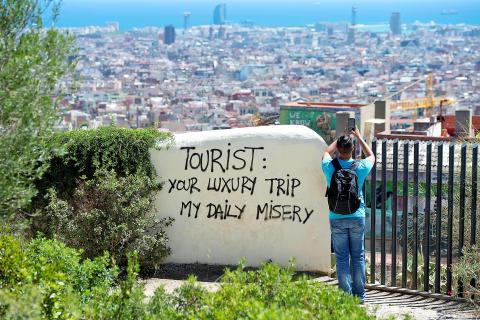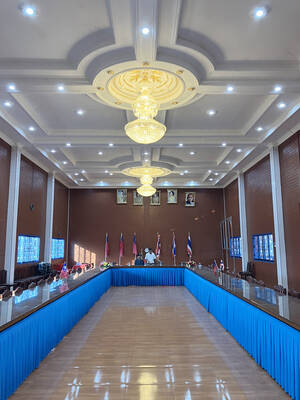How do you solve a problem like tourism? It employs hundreds of millions of people, buoys entire industries — but can tear apart the very cities that benefit from it, alienating residents and causing irreversible damage to their culture and heritage.
Protests across Europe have spurred talk of “responsible tourism” and forcing the sector to factor in sustainability, but the problem is already at such a scale that doing anything about it seems akin to turning around a cruise liner.
What’s the way out of this mess?

Photo: AFP
SPREAD THEM OUT
The most obvious solution to the problem of too many tourists is to spread them over a larger area, says Alex Dichter, a senior partner of McKinsey & Company consultancy, which in December produced a report on managing overcrowded tourist destinations.
Overcrowding is such a localized issue that even in a city apparently at breaking point, such as Barcelona, Dichter is “sure there are neighborhoods that are overwhelmed and there are others that are in need of quite a bit more”.
Many cities compound the problem by promoting only a small number of sites — often the obvious ones. Tourists can be dispersed by boosting less popular attractions and developing new ones.
Tell tourists: come back later ... and come back encouraging visitors outside of peak times of day, season and year similarly lessens their impact. If marketing alone doesn’t work, arrival limits and pricing adjustments might do the job, says Dichter.
Repeat visitors know the city better and venture beyond the must-see attractions. Laura Aalto, chief executive of Helsinki Marketing, says establishing a sense of “localhood” is key to a positive and often long-term relationship between a city and its visitors.
“Nobody wants to be a tourist, everybody wants to be part-time locals,” she says. “Our job is to create the kind of circumstances, conditions and platforms for visitors who come to Helsinki to meet with the locals and not go to the most obvious attractions.”
ANGLE FOR ‘GOOD’ ONES
... which is to say: no hen nights and stag dos. In Barcelona it is known as turismo de Borrachera — having a drunken party in a strange city in order to get away with behavior that would be considered unacceptable at home. Cities sell themselves on the strength of their cheap beer or nightlife at their peril. Amsterdam, for instance, has invested a lot in marketing itself as an arts and culture destination to shake off its reputation as a city-wide red-light district.
Aalto says profiling has revealed that visitors who come to Helsinki to engage with a specific interest (“whether that be design, architecture, education or heavy metal music”) are those who will bring the most reward.
“Those are the ones who will be our ambassadors for life, who are creating a relationship with the city and maybe come more and more often — they are the ones who are friends of Helsinki,” Aalto says.
Win the marketing marathon, not the sprint growth is too often the measure of a successful tourism industry, says Xavier Font, a professor of sustainability marketing at the University of Surrey.
“There is a sense unless we grow, we are not doing very well — but it’s causing huge problems,” Font says.
He suggests marketing smarter, not necessarily more — such as packages to attract visitors for five days, not just a weekend — and targeted upselling, to draw, for example, visitors to the Sagrada Familia to a crypt just outside Barcelona’s city center.
Even tweaks to advertising material can make a difference. Barcelona is still marketing itself with the same brochures it designed for the 1992 Olympics, says Font.
“The only thing that’s changed is that they have been translated into more languages. Sure, the history and heritage has not changed — but the way that we consume places has changed a lot.”
USE MARKET FORCES
Adjusting pricing can be a crude but effective means of balancing supply and demand: if a destination costs more to get to, fewer people are likely to go there. Introducing variable or tiered pricing and rates for residents can help to reduce criticisms of cultural elitism or of restricting domestic tourists from accessing their own heritage, says Dichter.
Many destinations have also introduced a tourist tax, revenues from which can be used to manage the industry. Font says the benefits of tourism need to be rebalanced in favor of sustainability, not hoteliers: “Why am I willing to pay hundreds of pounds a night to stay in a hotel but only a tenner to go to the Eiffel tower?”
However, he cautions that raising or reducing prices can often be a knee-jerk short-term response.
“Do it differently,” Font says. “We often mess around with the things that don’t need to be messed with.”
HEAD COUNT, BED COUNT
Many cities struggling with tourist numbers have placed direct controls on accommodation, whether that by halting construction on new hotels — as in the case of both Barcelona and Amsterdam — or capping short-term homesharing on Airbnb.
London, New York, Reykjavik, Amsterdam, Paris and many other cities have introduced limits, set mostly at about three months of the year, to prevent a shortage of housing supply and rent increases for locals.
Dichter says he understands the logic of a limit of about 90 days. “These cities are trying to create a natural equilibrium, where you don’t have an economic incentive one way or another.”
FIX THE FUNDAMENTALS
Companies such as Airbnb and Ryanair often bear the brunt of the blame for how tourism has ballooned beyond control, but that ignores the bigger picture of policies and loopholes that allow them to flourish.
Budget airlines can sell flights cheaply as a result of massive tax breaks for the aviation industry, which has driven up not only tourist numbers but carbon emissions. House prices go up and there becomes a shortage of supply when housing markets are deregulated to attract offshore investors. The hotel and construction industries can be symbiotic.
“When you allow international corporations to not pay corporate tax in a country, the social impact and cost is just huge,” Font says. “We can blame Airbnb for this, but it’s just the tip of the iceberg — there are a lot of factors that are not visible.”
Government resources need to be devoted to sustainable tourism, politicians need to be held more accountable, and residents need to be given the opportunity to weigh in outside of election time. “Because if we wait for once every four years, it’s too late,” he says.
KNOWLEDGE IS POWER
An effective strategy for managing tourists is informed by data.
“We talk to so many people in the tourism ecosystem and no one has the same facts — not even close,” says Dichter. “If you can’t even agree on how many tourists are showing up, it’s very difficult to have a proper debate.”
The more information collected on tourists at every level — national, regional, municipal and sites — the clearer picture of their true costs and benefits, including economic, social and environmental.
Dichter points to Amsterdam’s official app, which not only improves visitors’ experiences of the city but reports back on them too.
Font says combining even imperfect data from a wide enough range of sources — restaurants, hotels, electricity and water providers, airports — can be basis enough for cities to act. “We don’t need 100 percent perfect data to make some decisions when, more often than not, it is about trends.”
LOOK AFTER NUMBER ONE
If government and industry bodies actively consult communities on tourists’ impact, it can help to ease antagonism. Justin Francis, the director of the Responsible Travel agency, has proposed that all stakeholders work together to agree on specific signs — “limits of acceptable change”, such as resource shortages or price increases, that could
But any measures taken now will have a delayed effect, says Dichter.
“The only right answer is to plan.” That means drilling down into the details: “If you want more tourists, how many more? How many hotel rooms will sustain that? What’s your target mix from a nationality standpoint, and how will you work with suppliers to achieve that goal?”
Ultimately, residents must be prioritized over tourists for housing, infrastructure and access to services because they have a long-term stake in the city’s success.
“You need to put residents at the center of your decision making,” says Font.
“Cities are not the playgrounds of tourists; we only want them because they make the city more liveable for residents.”

May 26 to June 1 When the Qing Dynasty first took control over many parts of Taiwan in 1684, it roughly continued the Kingdom of Tungning’s administrative borders (see below), setting up one prefecture and three counties. The actual area of control covered today’s Chiayi, Tainan and Kaohsiung. The administrative center was in Taiwan Prefecture, in today’s Tainan. But as Han settlement expanded and due to rebellions and other international incidents, the administrative units became more complex. By the time Taiwan became a province of the Qing in 1887, there were three prefectures, eleven counties, three subprefectures and one directly-administered prefecture, with

Taiwan Power Co (Taipower, 台電) and the New Taipei City Government in May last year agreed to allow the activation of a spent fuel storage facility for the Jinshan Nuclear Power Plant in Shihmen District (石門). The deal ended eleven years of legal wrangling. According to the Taipower announcement, the city government engaged in repeated delays, failing to approve water and soil conservation plans. Taipower said at the time that plans for another dry storage facility for the Guosheng Nuclear Power Plant in New Taipei City’s Wanli District (萬里) remained stuck in legal limbo. Later that year an agreement was reached

What does the Taiwan People’s Party (TPP) in the Huang Kuo-chang (黃國昌) era stand for? What sets it apart from their allies, the Chinese Nationalist Party (KMT)? With some shifts in tone and emphasis, the KMT’s stances have not changed significantly since the late 2000s and the era of former president Ma Ying-jeou (馬英九). The Democratic Progressive Party’s (DPP) current platform formed in the mid-2010s under the guidance of Tsai Ing-wen (蔡英文), and current President William Lai (賴清德) campaigned on continuity. Though their ideological stances may be a bit stale, they have the advantage of being broadly understood by the voters.

In a high-rise office building in Taipei’s government district, the primary agency for maintaining links to Thailand’s 108 Yunnan villages — which are home to a population of around 200,000 descendants of the Chinese Nationalist Party (KMT) armies stranded in Thailand following the Chinese Civil War — is the Overseas Community Affairs Council (OCAC). Established in China in 1926, the OCAC was born of a mandate to support Chinese education, culture and economic development in far flung Chinese diaspora communities, which, especially in southeast Asia, had underwritten the military insurgencies against the Qing Dynasty that led to the founding of